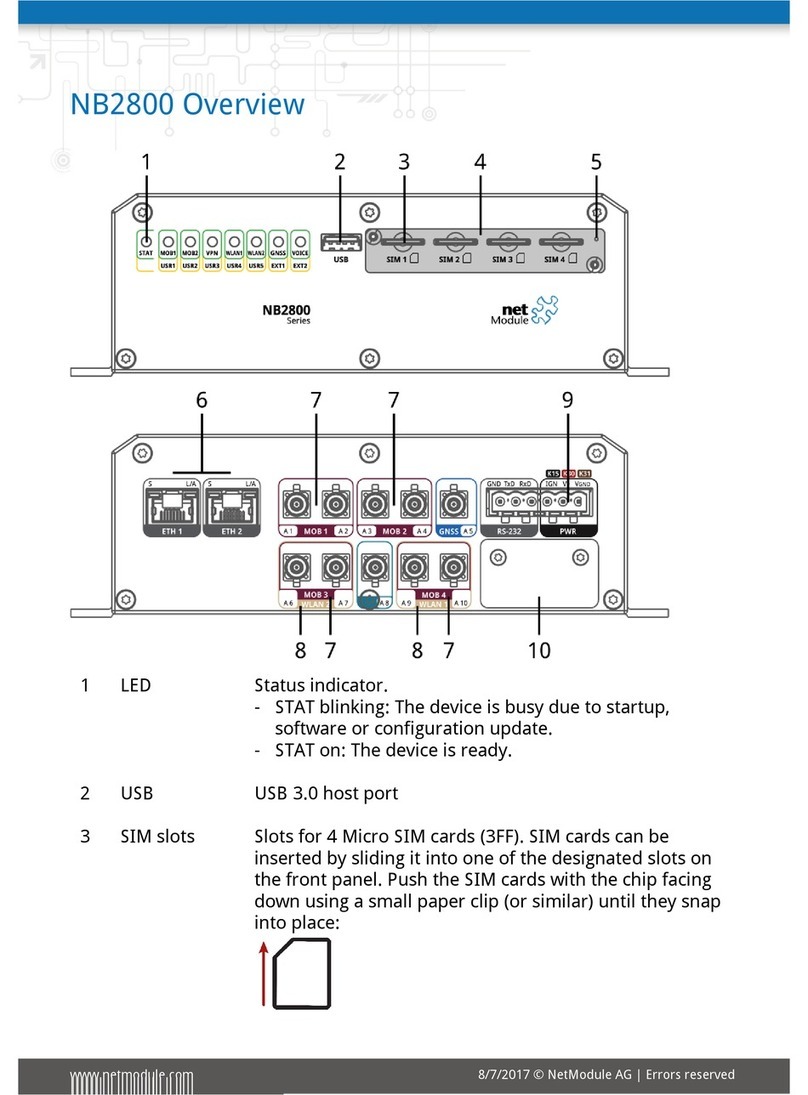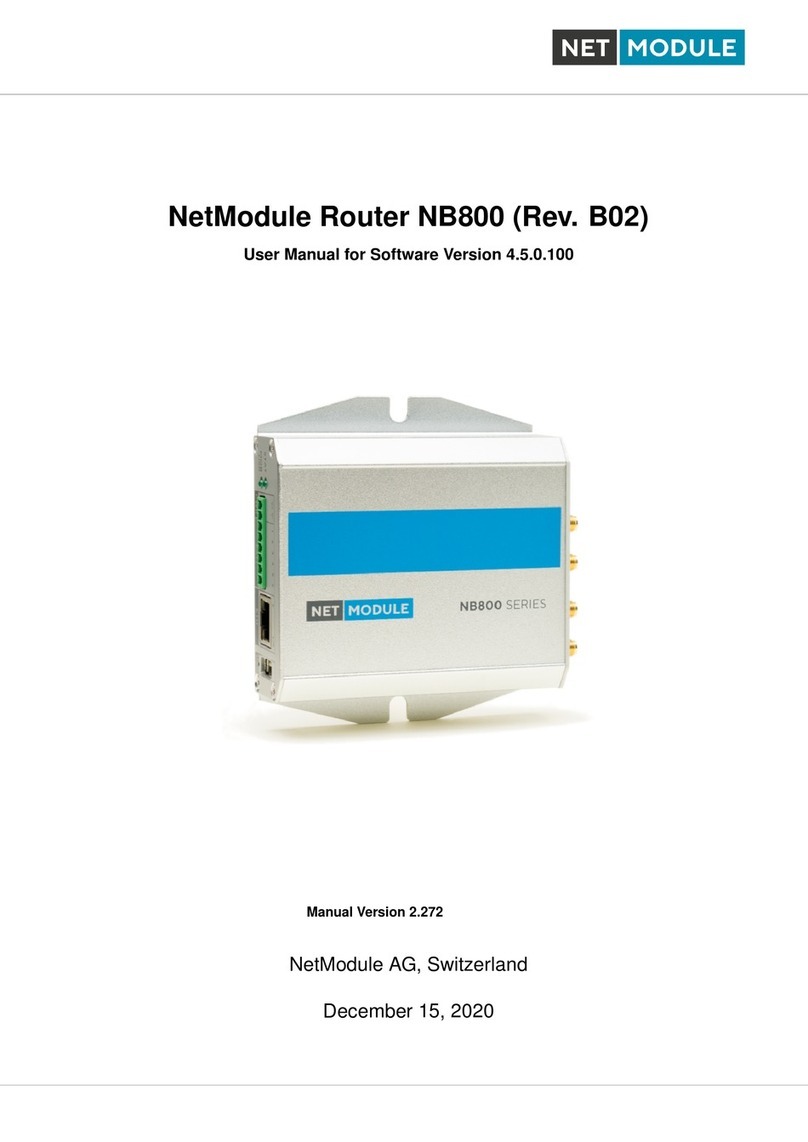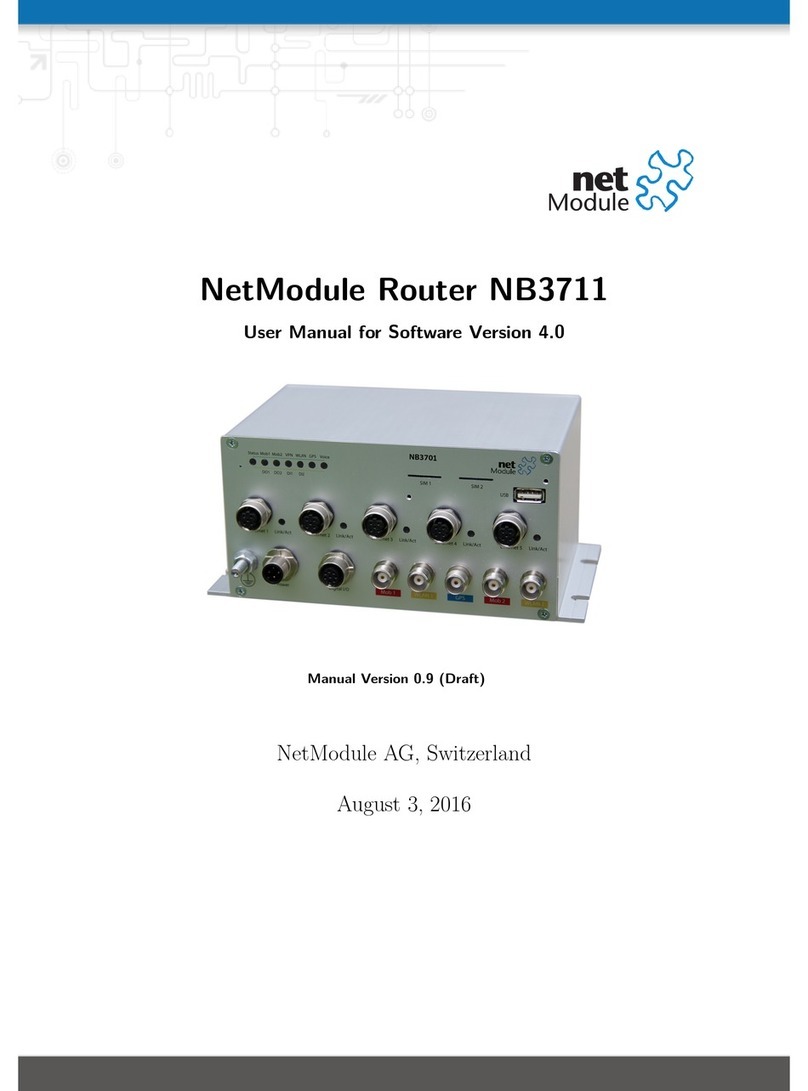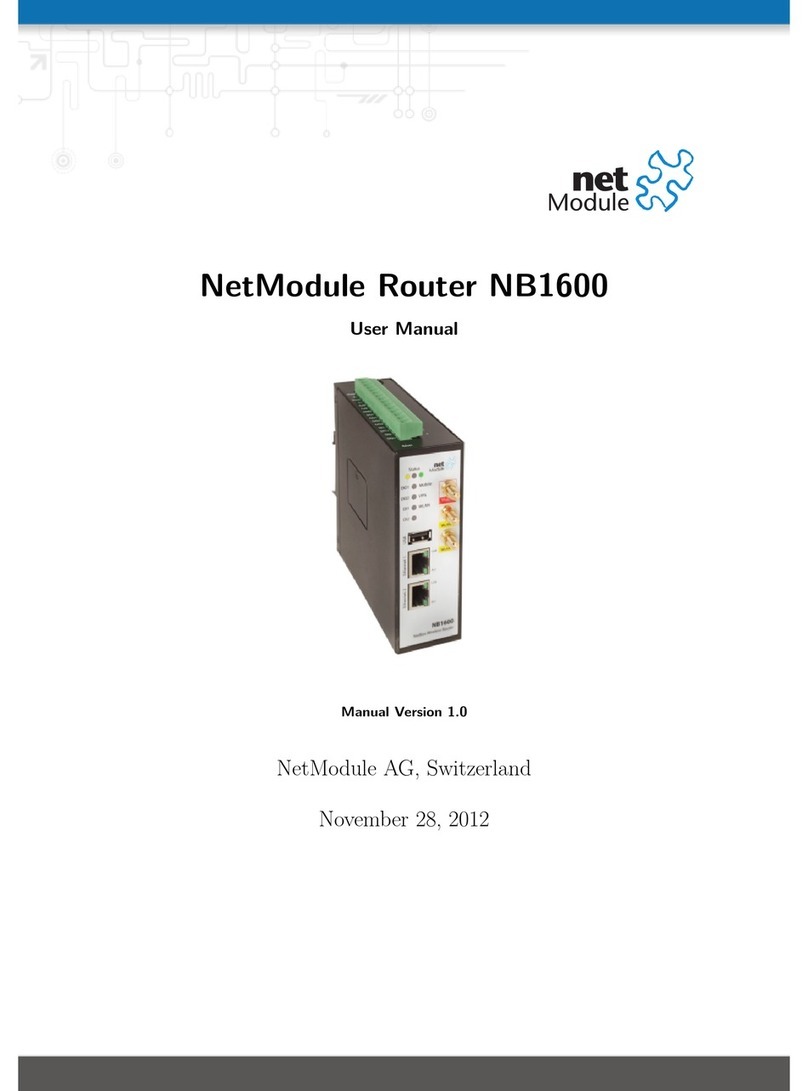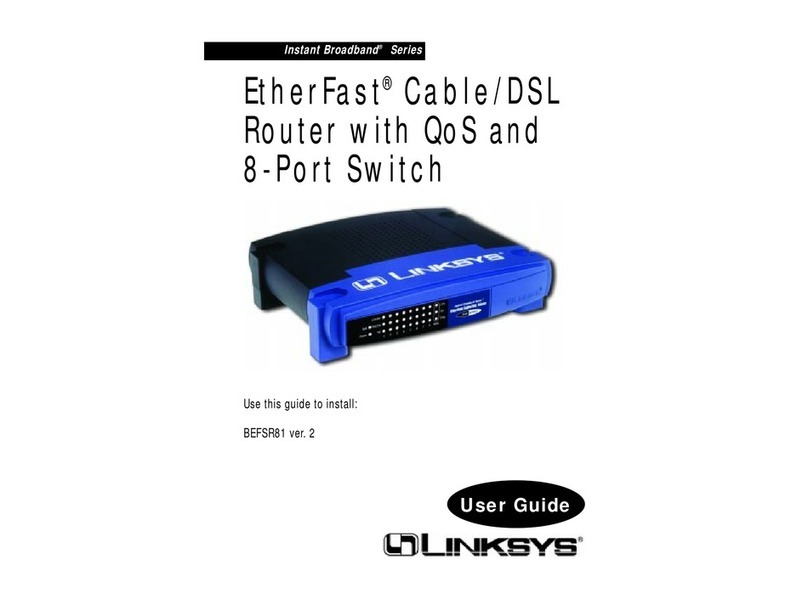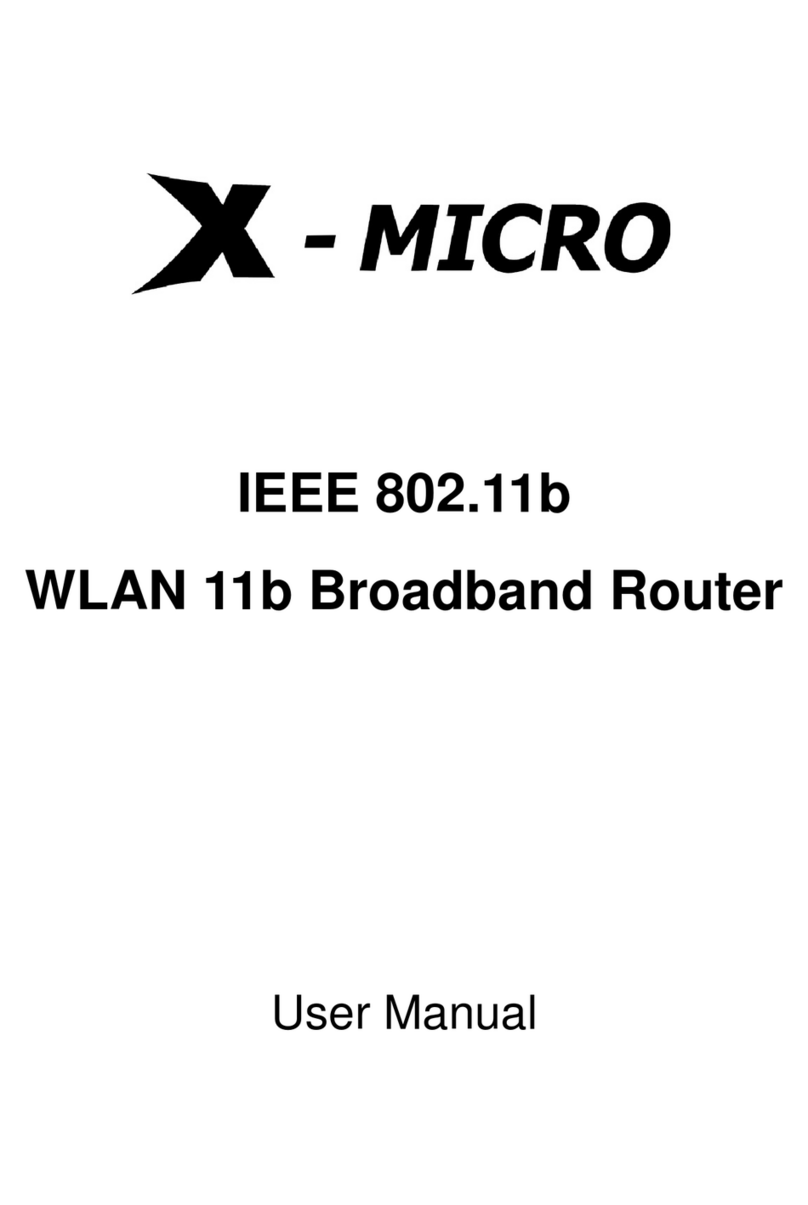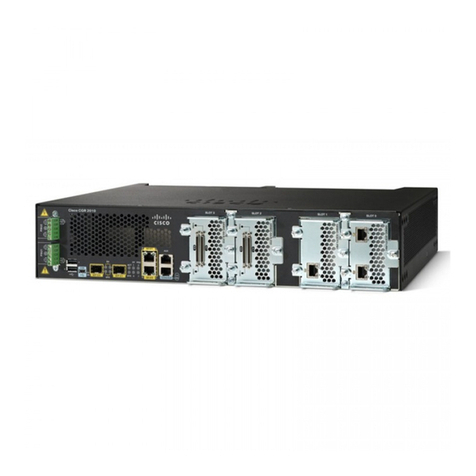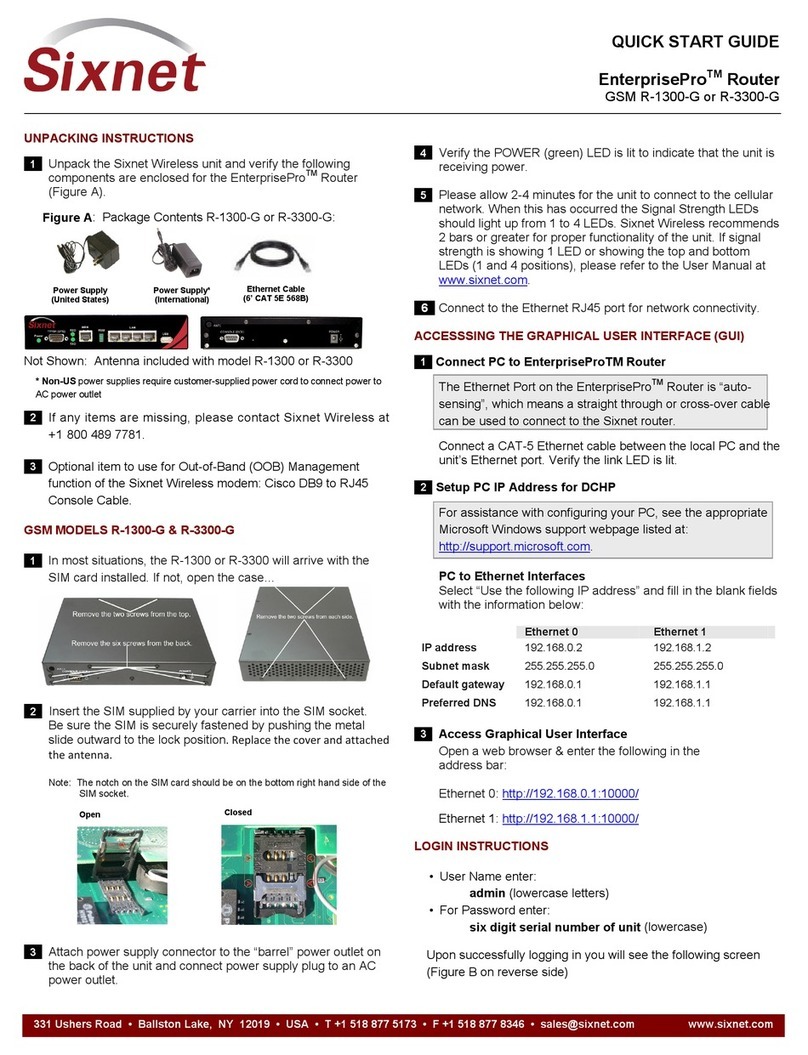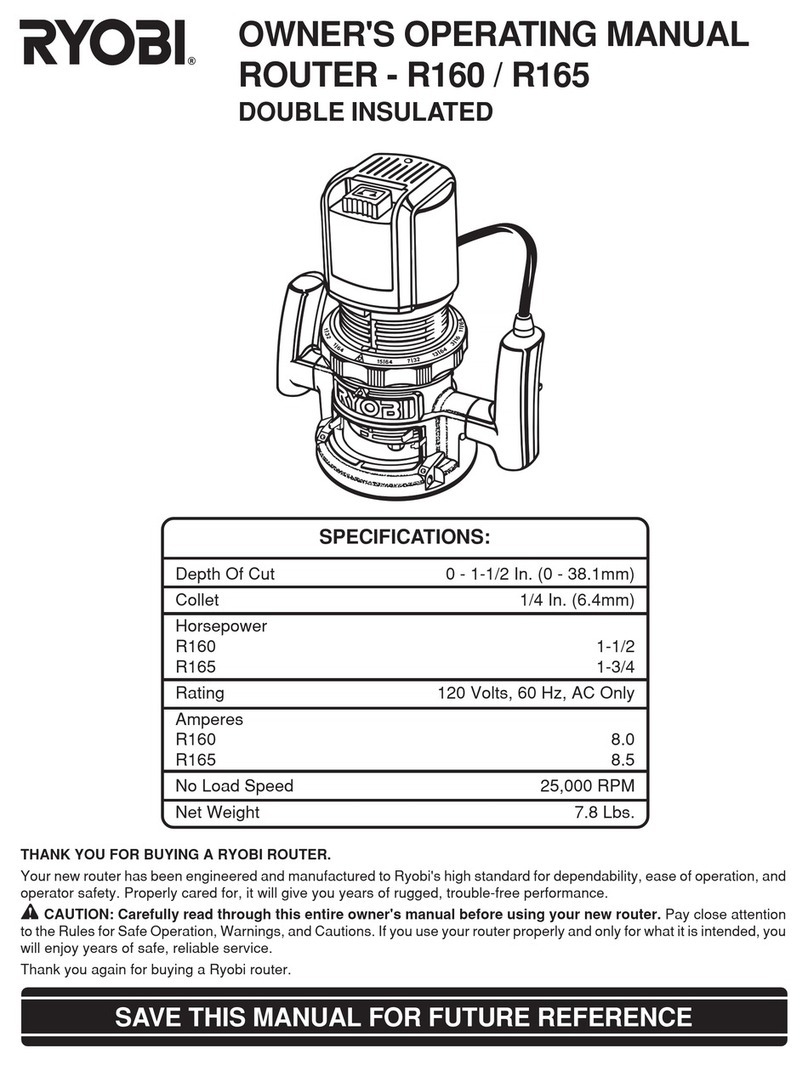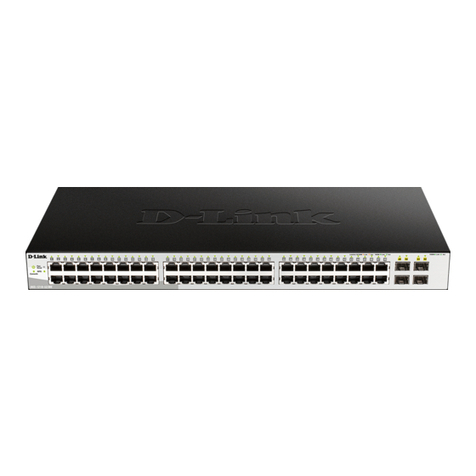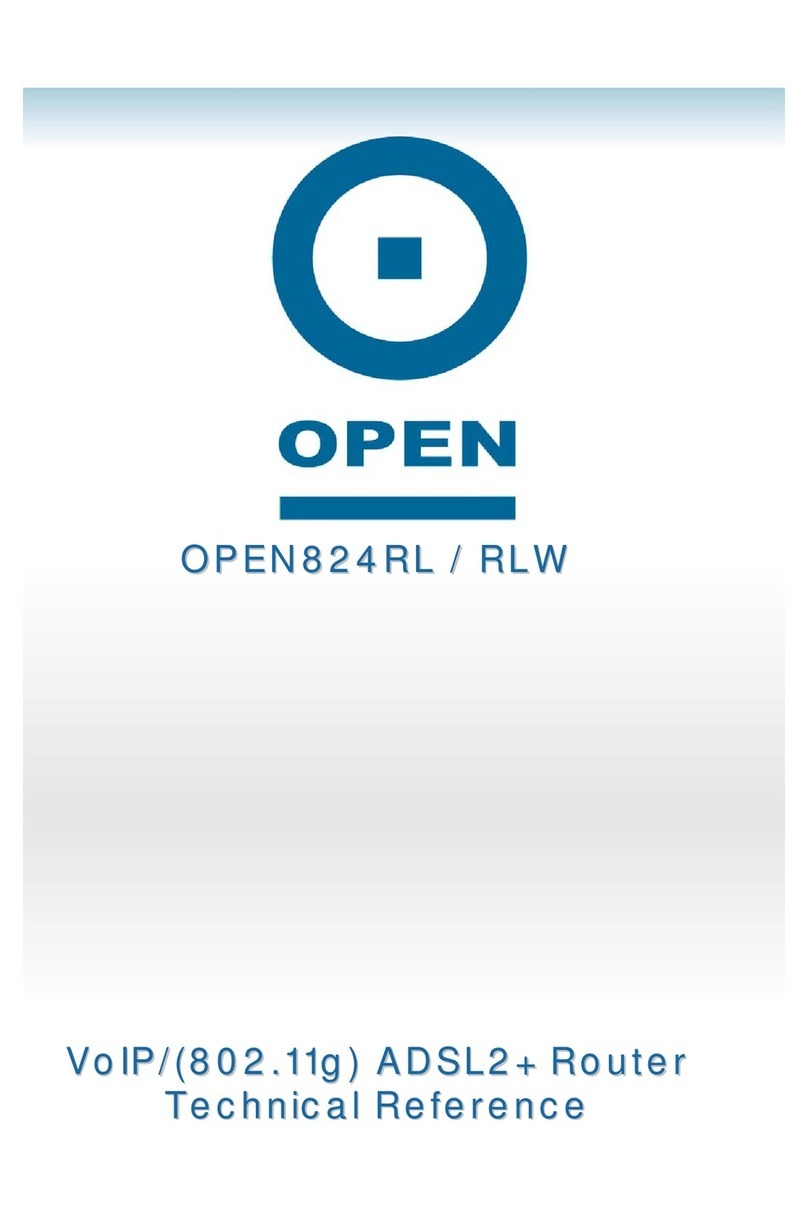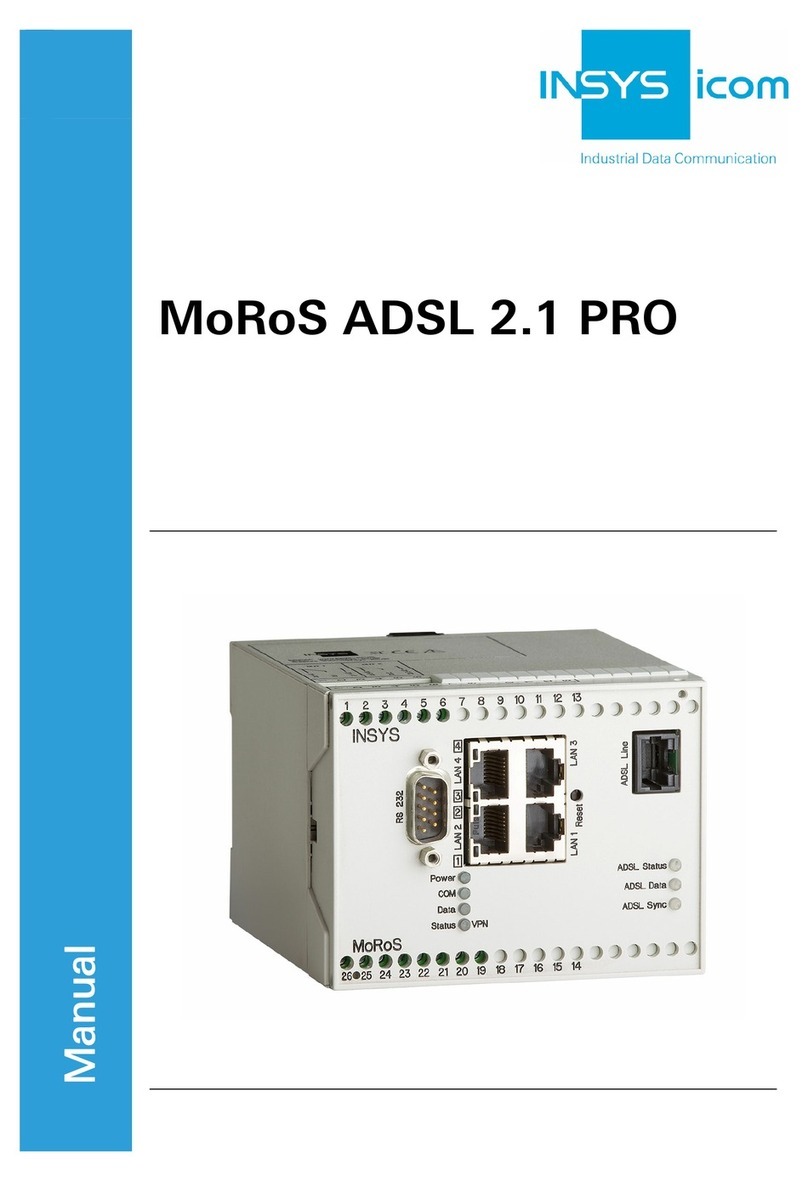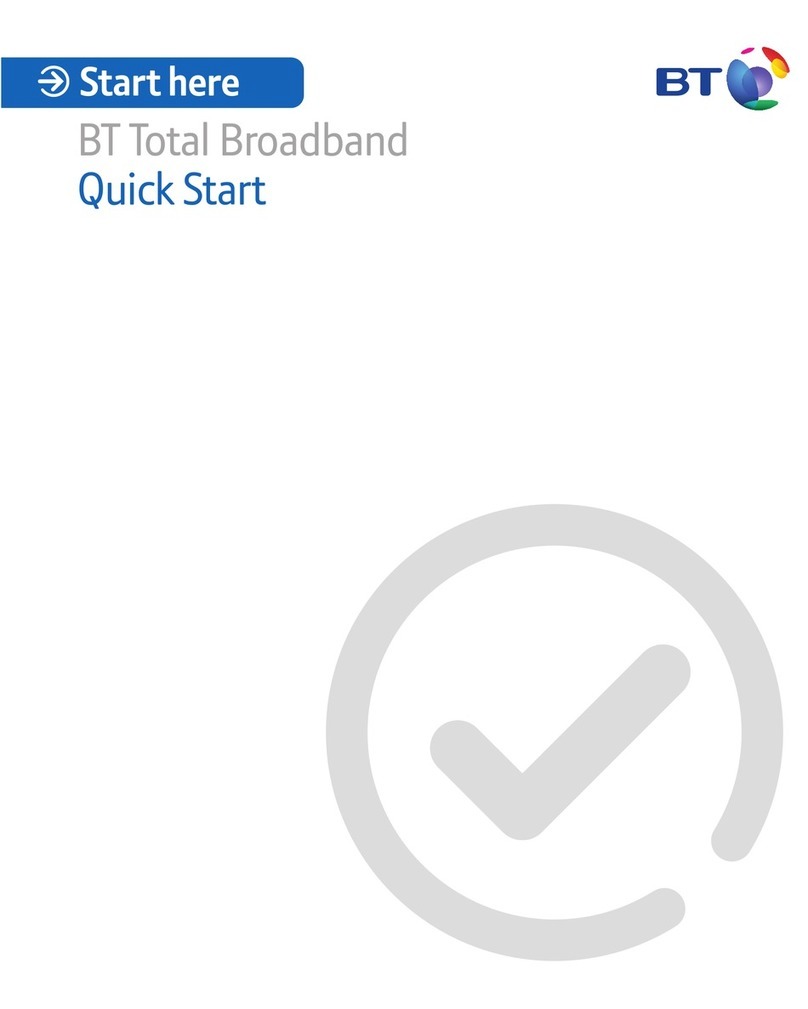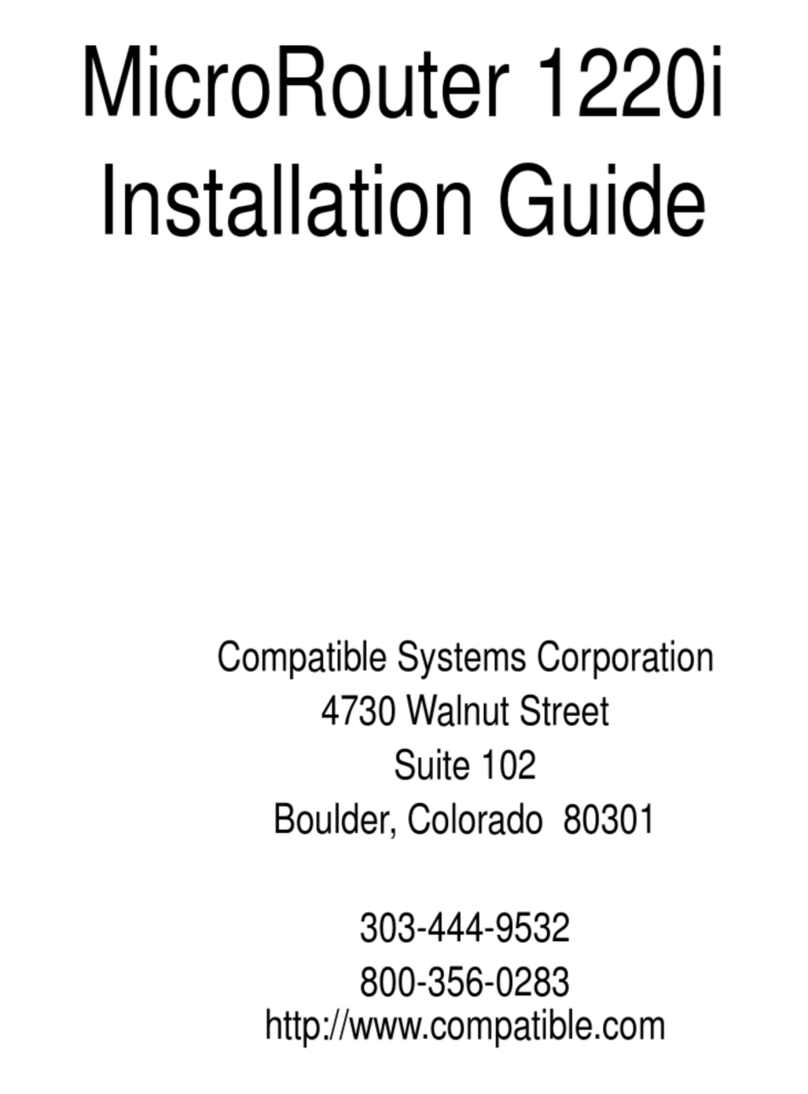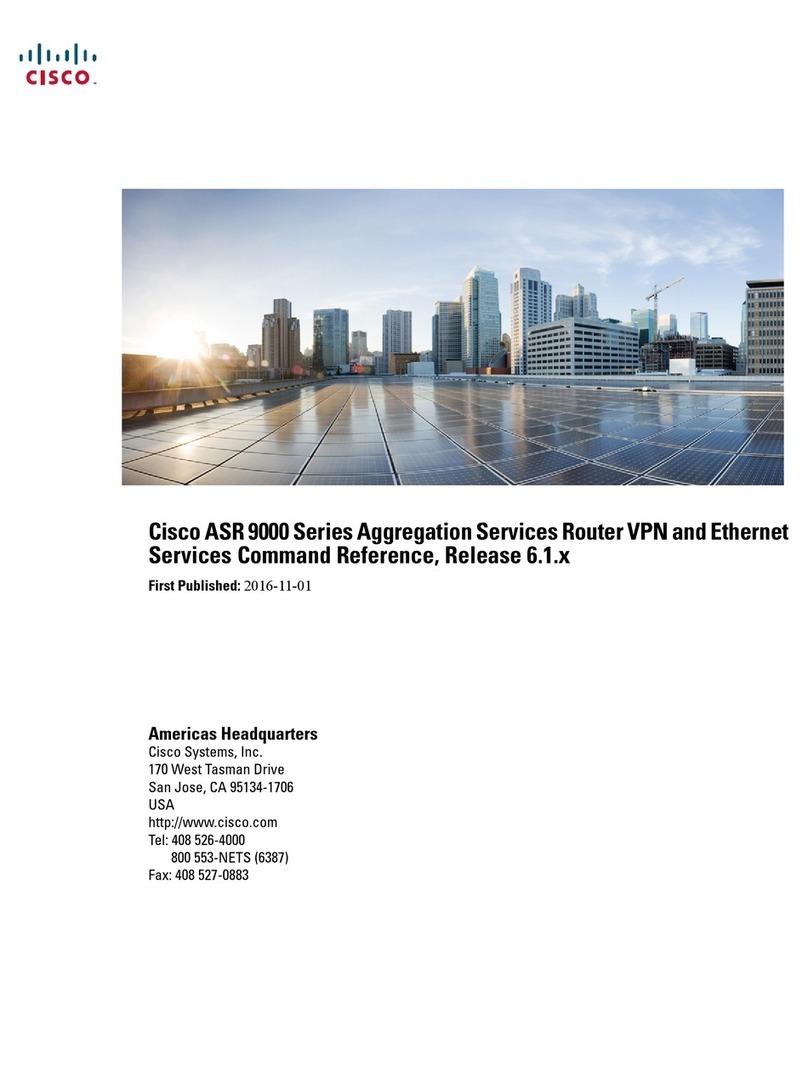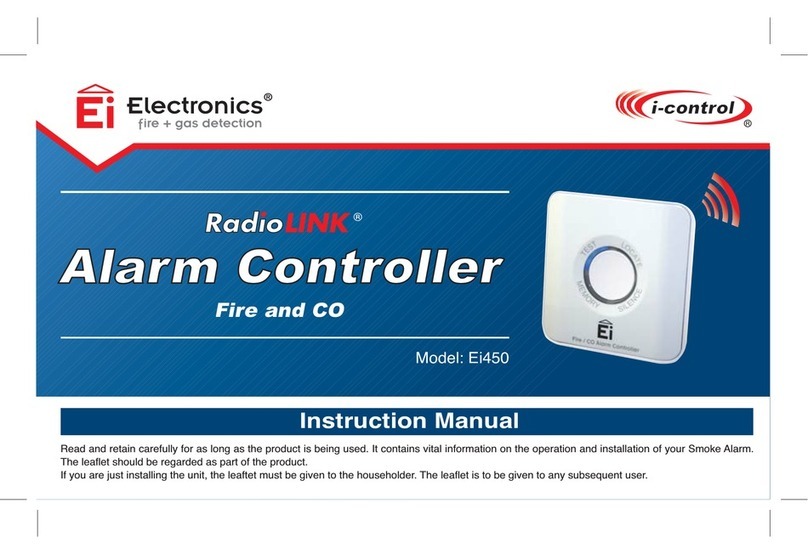NetModule NB3710 User manual

NetModule Router NB3710
User Manual for Software Version 4.0
Manual Version 1.8
NetModule AG, Switzerland
September 15, 2016

NetModule Router NB3710
This manual covers all variants of the NB3710 product type.
The specifications and information regarding the products in this manual are subject to change without
notice. We would like to point out that NetModule makes no representation or warranties with respect
to the contents herein and shall not be responsible for any loss or damage caused to the user by the direct
or indirect use of this information This document may contain information about third party products
or processes. Such third party information is generally out of influence of NetModule and therefore
NetModule shall not be responsible for the correctness or legitimacy of this information. Users must
take full responsibility for their application of any products.
Copyright ©2016 NetModule AG, Switzerland All rights reserved
This document contains proprietary information of NetModule. No parts of the work described herein
may be reproduced. Reverse engineering of the hardware or software is prohibited and protected by
patent law. This material or any portion of it may not be copied in any form or by any means, stored
in a retrieval system, adopted or transmitted in any form or by any means (electronic, mechanical,
photographic, graphic, optic or otherwise), or translated in any language or computer language without
the prior written permission of NetModule.
A large amount of the source code to this product is available under licenses which are both free and
open source. Most of it is covered by the GNU General Public License which can be obtained from
www.gnu.org. The remainder of the open source software which is not under the GPL, is usually
available under one of a variety of more permissive licenses. A detailed license information for a
particular software package can be provided on request.
NetModule and NB3710 are trademarks and the logo is a service mark of NetModule AG, Switzerland.
All other products or company names mentioned herein are used for identification purposes only and
may be trademarks or registered trademarks of their respective owners. The following description of
software, hardware or process of NetModule or other third party provider may be included with your
product and will be subject to the software, hardware or other license agreements.
Contact
www.netmodule.com/support
NetModule AG Tel +41 31 985 25 10
Meriedweg 11 Fax +41 31 985 25 11
CH-3172 Niederwangen info@netmodule.com
Switzerland http://www.netmodule.com
2

NB3710 User Manual 4.0
Contents
1 Welcome to NetModule 4
2 Conformity 5
2.1 Safety Instructions .............................. 5
2.2 Declaration of Conformity .......................... 6
2.3 Waste Disposal ................................ 6
2.4 National Restrictions ............................. 6
2.5 Open Source Software ............................ 7
3 Specifications 8
3.1 Features .................................... 8
3.2 Operating Elements .............................. 9
3.3 Interfaces ................................... 11
3.3.1 Overview ............................... 11
3.3.2 Mobile ................................. 12
3.3.3 WLAN ................................. 12
3.3.4 GPS .................................. 12
3.3.5 USB 2.0 Host Port .......................... 13
3.3.6 M12 Ethernet Connectors ...................... 13
3.3.7 Power Supply ............................. 14
3.3.8 Digital Inputs and Outputs ..................... 15
3.3.9 Extension Connector ......................... 16
4 Installation 22
4.1 Environmental Conditions .......................... 22
4.2 Installation of the Router .......................... 22
4.3 Installation of the Mini-SIM Card ...................... 22
4.4 Installation of the GSM/UMTS/LTE Antenna ............... 23
4.5 Installation of the WLAN Antennas ..................... 23
4.6 Installation of the GPS Antenna ....................... 23
4.7 Installation of the Local Area Network ................... 24
4.8 Installation of the Power Supply ....................... 24
3

NB3710 User Manual 4.0
5 Configuration 25
5.1 First Steps ................................... 25
5.1.1 Initial Access ............................. 26
5.1.2 Recovery ................................ 27
5.2 HOME ..................................... 28
5.3 INTERFACES ................................ 31
5.3.1 WAN .................................. 31
5.3.2 Ethernet ................................ 37
5.3.3 Mobile ................................. 43
5.3.4 WLAN ................................. 48
5.3.5 USB .................................. 55
5.3.6 Serial Port ............................... 58
5.3.7 Digital I/O .............................. 61
5.3.8 GNSS ................................. 62
5.4 ROUTING ................................... 65
5.4.1 Static Routes ............................. 65
5.4.2 Extended Routing .......................... 67
5.4.3 Multipath Routes ........................... 69
5.4.4 Mobile IP ............................... 70
5.4.5 Quality Of Service .......................... 73
5.4.6 Multicast ............................... 75
5.4.7 OSPF ................................. 76
5.4.8 BGP .................................. 78
5.5 FIREWALL .................................. 79
5.5.1 Administration ............................ 79
5.5.2 Adress/Port Groups ......................... 79
5.5.3 Rules .................................. 80
5.5.4 NAPT ................................. 82
5.6 VPN ...................................... 86
5.6.1 OpenVPN ............................... 86
5.6.2 IPsec .................................. 92
5.6.3 PPTP ................................. 98
5.6.4 GRE ..................................101
5.6.5 Dial-In .................................102
5.7 SERVICES ..................................104
5.7.1 SDK ..................................104
5.7.2 DHCP Server .............................115
5.7.3 DNS Server ..............................117
5.7.4 NTP Server ..............................119
5.7.5 Dynamic DNS ............................. 120
5.7.6 E-Mail .................................122
5.7.7 Events .................................124
4

NB3710 User Manual 4.0
5.7.8 SMS ..................................125
5.7.9 SSH/Telnet Server ..........................128
5.7.10 SNMP Agent .............................130
5.7.11 Web Server ..............................136
5.7.12 Redundancy ..............................137
5.7.13 Voice Gateway ............................139
5.8 SYSTEM ...................................146
5.8.1 System .................................146
5.8.2 Authentication ............................149
5.8.3 Software Update ...........................152
5.8.4 Module Firmware Update ......................153
5.8.5 Software Profiles ...........................153
5.8.6 Configuration .............................154
5.8.7 Troubleshooting ............................158
5.8.8 Keys and Certificates ......................... 161
5.8.9 Licensing ...............................166
5.8.10 Legal Notice ..............................167
5.9 LOGOUT ...................................168
6 Command Line Interface 169
6.1 General Usage ................................. 169
6.2 Print Help ...................................170
6.3 Getting Config Parameters ..........................171
6.4 Setting Config Parameters ..........................171
6.5 Getting Status Information ..........................172
6.6 Scanning Networks ..............................173
6.7 Sending E-Mail or SMS ............................173
6.8 Updating System Facilities ..........................173
6.9 Manage keys and certificates .........................174
6.10 Restarting Services .............................. 174
6.11 Debug System .................................175
6.12 Resetting System ...............................176
6.13 Rebooting System ...............................176
6.14 Running Shell Commands ..........................176
6.15 Working with History .............................177
6.16 CLI-PHP ...................................177
A Appendix 183
A.1 Abbrevations .................................183
A.2 System Events .................................185
A.3 Factory Configuration ............................ 188
A.4 SNMP VENDOR MIB ............................189
5

A.5 SDK Examples ................................203
List of Figures
5.1 Initial Login .................................. 26
5.2 Home ..................................... 28
5.3 WAN Links .................................. 31
5.4 WAN Settings ................................. 34
5.5 Link Supervision ............................... 35
5.6 Ethernet Ports ................................ 37
5.7 Ethernet Link Settings ............................ 38
5.8 VLAN Management ............................. 39
5.9 LAN IP Configuration ............................ 41
5.10 SIMs ...................................... 43
5.11 WWAN Interfaces ............................... 46
5.12 WLAN Management ............................. 48
5.13 WLAN Configuration ............................. 52
5.14 WLAN IP Configuration ........................... 54
5.15 USB Administration ............................. 55
5.16 USB Device Management .......................... 56
5.17 Serial Port Administration .......................... 58
5.18 Serial Port Settings .............................. 59
5.19 Digital I/O Ports ............................... 61
5.20 Static Routing ................................. 65
5.21 Extended Routing ............................... 67
5.22 Multipath Routes ............................... 69
5.23 Mobile IP ................................... 72
5.24 Firewall Groups ................................ 79
5.25 Firewall Rules ................................. 80
5.26 Masquerading ................................. 82
5.27 Inbound NAPT ................................ 85
5.28 OpenVPN Administration .......................... 86
5.29 OpenVPN Configuration ........................... 87
5.30 OpenVPN Client Management ........................ 91
5.31 IPsec Administration ............................. 93
5.32 IPsec Configuration .............................. 94
5.33 PPTP Administration ............................ 98
6

5.34 PPTP Tunnel Configuration ......................... 99
5.35 PPTP Client Management ..........................100
5.36 Dial-in Server Settings ............................ 102
5.37 SDK Administration .............................109
5.38 SDK Jobs ...................................112
5.39 DHCP Server ................................. 116
5.40 DNS Server ..................................117
5.41 NTP Server .................................. 119
5.42 Dynamic DNS Settings ............................ 120
5.43 E-Mail Settings ................................122
5.44 SMS Configuration .............................. 126
5.45 SSH and Telnet Server ............................128
5.46 SNMP Agent .................................131
5.47 Web Server .................................. 136
5.48 VRRP Configuration ............................. 137
5.49 Voice Gateway Administration ........................139
5.50 Voice Gateway Endpoint Configuration ...................141
5.51 Voice Gateway Routing Configuration ....................144
5.52 System ..................................... 146
5.53 Regional settings ............................... 148
5.54 User Accounts .................................149
5.55 Remote Authentication ............................ 151
5.56 Manual File Configuration ..........................154
5.57 Automatic File Configuration ........................ 155
5.58 Factory Configuration ............................156
5.59 Log Viewer ..................................159
5.60 Tech Support File ...............................160
5.61 Keys and certificates .............................161
5.62 Certificate Configuration ...........................163
5.63 Licensing .................................... 166
List of Tables
3.1 NB3710 Status Indicators .......................... 10
3.2 NB3710 Interfaces ............................... 11
3.3 Mobile Interface ................................ 12
3.4 IEEE 802.11 Standards ............................ 12
7

NB3710 User Manual 4.0
3.5 GPS Specifications .............................. 13
3.6 GNSS Specifications ............................. 13
3.7 USB 2.0 Host Port Specification ....................... 13
3.8 Ethernet Port Specification ......................... 14
3.9 Pin Assignments of Ethernet Connectors .................. 14
3.10 Power Input Specifications .......................... 15
3.11 Pin Assignments of Power Connector .................... 15
3.12 Common Digital I/O Specification ...................... 15
3.13 Isolated Digital Outputs Specification .................... 15
3.14 Isolated Digital Inputs Specification ..................... 16
3.15 Pin Assignments of Digital Inputs and Outputs .............. 16
3.16 Pin Assignments of Digital Inputs and Outputs .............. 17
3.17 Audio Port Specification ........................... 17
3.18 Pin Assignments of Audio Port Signals (EP1 / EP2) ........... 18
3.19 CAN Port Specification ............................ 18
3.20 Pin Assignments of CAN Port Signals (EP1 / EP2) ............ 18
3.21 IBIS Port Specification ............................ 19
3.22 Pin Assignments of IBIS Port Signals (EP1 / EP2) ............ 19
3.23 Non-isolated RS-232 Port Specification ................... 19
3.24 Pin Assignments of RS-232 Port Signals (EP1 / EP2) ........... 20
3.25 Isolated RS-232 Port Specification ...................... 20
3.26 Pin Assignments of RS-232 Port Signals (EP1 / EP2) ........... 20
3.27 RS-485 Port Specification .......................... 21
3.28 Pin Assignments of RS-485 Port Signals (EP1 / EP2) ........... 21
4.1 Operating Conditions ............................. 22
5.18 IEEE 802.11 Network Standards ....................... 50
5.36 Static Route Flags .............................. 66
5.79 SMS Control Commands ...........................114
5.88 SMS Number Expressions ..........................125
5.118Certificate Sections .............................. 162
5.119Certificate Operations ............................ 162
A.1 Abbreviations .................................185
A.2 System Events .................................187
A.3 SDK Examples ................................ 206
8

1. Welcome to NetModule
Thank you for purchasing a NetModule Router. This document should give you an
introduction to the router and its features. The following chapters describe any aspects
of commissioning the device, installation procedure and provide helpful information
towards configuration and maintenance.
Please find further imformation such as sample SDK script or configuration samples in
our wiki on http://wiki.netmodule.com.
9

2. Conformity
This chapter provides general information for putting the router into operation.
2.1. Safety Instructions
NetModule routers must be used in compliance with any and all applicable national
and international laws and with any special restrictions regulating the utilization of the
communication module in prescribed applications and environments.
We would like to point out that only the original accessories, shipping with the router,
must be used in order to prevent possible injury to health or damage to appliances and
to ensure that all the relevant provisions have been complied with. Unauthorized mod-
ifications or utilization of unapproved accessories may void the warranty. The routers
must not be opened. However, it is possible to replace any pluggable SIM cards even
during operation.
All circuits connected to the interfaces of the router must comply with the requirements
of Safety Extra Low Voltage (SELV) circuits and have to be designed for indoor use only.
Interconnections must not leave the building nor penetrate the body shell of a vehicle.
Possible antenna circuits must be limited to over-voltage transient levels below 1 500 VDC
(according to IEC 60950-1, TNV-1 circuit levels) by using safety approved components.
NB3710 routers shall only be used with a certified (CE or equivalent) power supply
which must have a power limited and SELV circuit1output.
They are basically designed for indoor use. Do not expose the communication module
to extreme ambient conditions and protect the communication module against dust,
moisture and high temperature.
We remind the user of the duty to observe the restrictions concerning the utilization of
radio devices at petrol stations, in chemical facilities or in the course of blasting works
in which explosives are used. Switch off the communication module when traveling by
plane.
You need to pay increased attention when using the communication module close to
personal medical devices, such as cardiac pacemakers or hearing aids. NetModule routers
may also cause interference in the nearer distance of TV sets, radio receivers and personal
computers.
Avoid any installation of the antenna during a lightning. Always keep a distance of more
1Note: Power supplies for routers with the Pb option (72-110 VDC) cannot be a SELV circuit, since
the voltage is greater than 60 VDC.
10

NB3710 User Manual 4.0
than 40 cm from the antenna in order to reduce exposure to electromagnetic fields below
the legal limits. This distance applies to λ
4- and λ
2-antennas. Larger distances may apply
to antennas with higher gain.
Any Ethernet cabling must be shielded, the Ethernet section of this manual provides
more information.
Devices with a WLAN interface may be operated only with applicable Regulatory Do-
main configured. Special attention must be paid to country, number of antennas and
the antenna gain (see also chapter 5.3.4). A misconfiguration will lead to loss of the
approval.
Cellular antennas attached to the router must have an antenna gain of equal or less than
2.5 dBi. If an extension cable is used to attach the antenna, the antenna gain may be
higher by the amount of cable attenuation. The user is responsible for the compliance
with the legal regulations.
We highly recommended creating a copy of a working system configuration. It can
be downloaded using the Web Manager and easily applied to a newer software release
afterwards as we generally guarantee backward compatibility.
2.2. Declaration of Conformity
NetModule hereby declares that under our own responsibility that the
routers comply with the relevant standards following the provisions of
the Council Directive 1999/5/EC. The signed version of the Declara-
tions of Conformity can be found on the NetModule web page.
2.3. Waste Disposal
In accordance with the requirements of the Council Directive
2002/96/EC regarding Waste Electrical and Electronic Equipment
(WEEE), you are urged to ensure that this product will be segregated
from other waste at end-of-life and delivered to the WEEE collection
system in your country for proper recycling.
2.4. National Restrictions
This product may be generally used in all EU countries (and other countries following the
EU directive 1999/5/EC) without any limitation. Please refer to our WLAN Regulatory
Database for getting further national radio interface regulations and requirements for a
particular country.
11

NB3710 User Manual 4.0
2.5. Open Source Software
We inform you that NetModule products may contain in part open-source software.
We are distributing such open-source software to you under the terms of GNU General
Public License (GPL)2, GNU Lesser General Public License (LGPL)3or other open-
source licenses4. These licenses allow you to run, copy, distribute, study, change and
improve any software covered by GPL, Lesser GPL, or other open-source licenses with-
out any restrictions from us or our end user license agreement on what you may do
with that software. Unless required by applicable law or agreed to in writing, software
distributed under open-source licenses is distributed on an "AS IS" basis, WITHOUT
WARRANTIES OR CONDITIONS OF ANY KIND, either express or implied.
To obtain the corresponding open source codes covered by these licenses, please contact
our technical support at router@support.netmodule.com.
Acknowledgements
This product includes:
•PHP, freely available from http://www.php.net
•Software developed by the OpenSSL Project for use in the OpenSSL Toolkit
(http://www.openssl.org)
•Cryptographic software written by Eric Young (ea[email protected])
•Software written by Tim Hudson ([email protected])
•Software written Jean-loup Gailly and Mark Adler
•MD5 Message-Digest Algorithm by RSA Data Security, Inc.
•An implementation of the AES encryption algorithm based on code released by
Dr Brian Gladman
•Multiple-precision arithmetic code originally written by David Ireland
•Software from The FreeBSD Project (http://www.freebsd.org)
2Please find the GPL text under http://www.gnu.org/licenses/gpl-2.0.txt
3Please find the LGPL text under http://www.gnu.org/licenses/lgpl.txt
4Please find the license texts of OSI licenses (ISC License, MIT License, PHP License v3.0, zlib License)
under http://opensource.org/licenses
12

3. Specifications
3.1. Features
All models of NB3710 have the following standard functionalities:
•Galvanically isolated power supply
•5 Ethernet ports (M12, 10/100 Mbps)
•1 USB 2.0 host port
•2 digital inputs, 2 digital outputs
•4 mini SIM card slots
•Extension port
The NB3710 can be equipped with the following options:
•LTE / LTE 450MHz / LTE US
•CDMA 450MHz
•WLAN IEEE 802.11abgn
•GPS/GNSS
•GSM-R
•RS-232
•RS-485
•IBIS
•CAN
•Audio
•Power Supply 72 , 96, 110 VDC
•64 GB internal storage
•Software Key GPS
•Software Key Mobile IP
•Software Key Server
•Software Key Voice
Note:All LTE models include support for UMTS/EDGE/GPRS.
Due to its modular approach, the NB3710 router and its hardware components can be
arbitrarily assembled according to its indented usage or application. Please contact us
in case of special project requirements.
13

NB3710 User Manual 4.0
3.2. Operating Elements
The following table describes the NB3710 status indicators.
Label Color State Function
Status lblinking The device is busy due to startup, software or configu-
ration update.
lon The device is ready. The captions of the top bank apply.
lon The device is ready. The captions of the bottom bank
apply.
Mob1 lll[1] on Mobile connection 1 is up.
lblinking Mobile connection 1 is being established.
moff Mobile connection 1 is down.
Mob2 lll[1] on Mobile connection 2 is up.
lblinking Mobile connection 2 is being established.
moff Mobile connection 2 is down.
WLAN1 lll[1] on WLAN connection 1 is up.
lblinking WLAN connection 1 is being established.
moff WLAN connection 1 is down.
WLAN2 lll[1] on WLAN connection 2 is up.
lblinking WLAN connection 2 is being established.
moff WLAN conne ction 2 is down.
GNSS lon GNSS is turned on and a valid NMEA stream is avail-
able.
lblinking GNSS is searching for satellites.
moff GNSS is turned off or no valid NMEA stream is avail-
able.
Voice lon A voice call is currently active.
moff No voice call is active.
DO1 lon Normally open output port 1 is closed.
moff Normally open output port 1 is open.
14

NB3710 User Manual 4.0
Label Color State Function
DO2 lon Normally closed output port 2 is closed.
moff Normally closed output port 2 is open.
DI1 lon Input port 1 is set.
moff Input port 1 is not set.
DI2 lon Input port 2 is set.
moff Input port 2 is not set.
Ext1 lon Extension port 1 is on.
moff Extension port 1 is off.
Ext2 lon Extension port 2 is on.
moff Extension port 2 is off.
[1] The color of the LED represents the signal quality for wireless links.
lred means low
lyellow means moderate
lgreen means good or excellent
Table 3.1.: NB3710 Status Indicators
15

NB3710 User Manual 4.0
3.3. Interfaces
3.3.1. Overview
Label Panel Function
SIM 1 Front SIM 1, it can be assigned dynamically to any modem by
configuration.
SIM 2 Front SIM 2, it can be assigned dynamically to any modem by
configuration.
SIM 3 Front SIM 3, it can be assigned dynamically to any modem by
configuration.
SIM 4 Front SIM 4, it can be assigned dynamically to any modem by
configuration.
USB Front USB 2.0 host port, can be used as USB device server or for
software/configuration updates.
Ethernet 1-5 Front Ethernet switch ports, can be used as LAN or WAN inter-
face.
Front Earth protection connector, connected to the ground of the
power supply VGND. If used, connect a yellow-green marked
cable with at least 6mm2copper area. Avoid corrosion and
protect the screws against loosening.
Power Front Power supply (galvanically isolated)
Digital I/O Front Galvanically isolated digital I/O M12 connector
Extension Front Galvanically isolated extension ports M12 connector
Mob 1 Front TNC female connectors for MIMO mobile antenna 1
Mob 2 Front TNC female connectors for MIMO mobile antenna 2
WLAN 1 Front TNC female connectors for MIMO WLAN antenna
WLAN 2 Front TNC female connectors for MIMO WLAN antenna
GNSS Front TNC female connector for GPS/GLONASS antenna
Reset Front Reset button, press at least 3 seconds for reboot and at least
10 second for a factory reset. The start of the factory reset is
confirmed by all LEDs lighting up for a second. The button
can be released then again.
Table 3.2.: NB3710 Interfaces
16

NB3710 User Manual 4.0
3.3.2. Mobile
The various variants of the NB3710support up to two multimode modules for mobile
communication.
Standard Bands
4G (LTE/FDD) B1(2100), B2(1900), B3(1800), B5(850), B7(2600),
B8(900), B20(800)
3G (DC-HSPA+/UMTS) B5(850), B8(900), B2(1900), B1(2100)
2G (EDGE/GPRS/GSM) B9(900), B3(1800), B2(1900)
nmTableRowTwoColumns
GSM-R (data only) GSM-
R/ EGSM900/ GSM1800
LTE450
LTE Band 3 (1800 MHz), LTE Band 7 (2600 MHz), LTE
Band 20 (800 MHz), LTE Band 31 (450 MHz), UMTS
Band 1 (2100 MHz), UMTS Band 8 (900 MHz)
CDMA450 Band Class 5 Block Designators A + B
Table 3.3.: Mobile Interface
The LTE modules support 2x2 MIMO.
Data rates: LTE max. 100 Mbps downlink / 50 Mbps uplink (DC-HSPA+ 42/5.76);
CDMA450 max. 14,7 Mbps downlink / 5.4 Mbps uplink
3.3.3. WLAN
The variants of the NB3710support 802.11 a/b/g/n WLAN modules. It can operate
either as client or access point.
Standard Frequencies Bandwidth Data Rate
802.11a 5 GHz 20 MHz 54 Mbit/s
802.11b 2.4 GHz 20 MHz 11 Mbit/s
802.11g 2.4 GHz 20 MHz 54 Mbit/s
802.11n 2.4/5 GHz 20/40 MHz 300 Mbit/s
Table 3.4.: IEEE 802.11 Standards
Note: 802.11n supports 2x2 MIMO
3.3.4. GPS
17

NB3710 User Manual 4.0
Feature Specification
Systems GPS/GLONASS
Data stream JSON or NMEA
Tracking sensitivity -154 dBm
Supported antennas Active and passive
Table 3.5.: GPS Specifications
GNSS (Option Ge)
The GNSS module supports Dead Reckoning with onboard 3D accelerometer and 3D
gyroscope.
Feature Specification
Systems GPS/GLONASS/BeiDu/Galileo ready
Data stream NMEA or UBX
Tracking sensitivity -160 dBm
Channels 72
Accuracy 2m
Supported antennas Active and passive
Table 3.6.: GNSS Specifications
3.3.5. USB 2.0 Host Port
The USB 2.0 host port has the following specification:
Feature Specification
Speed Low, Full & Hi-Speed
Current max. 500 mA
Table 3.7.: USB 2.0 Host Port Specification
3.3.6. M12 Ethernet Connectors
Specification
The five Ethernet ports have following specification:
18

NB3710 User Manual 4.0
Feature Specification
Isolation 1500 VDC
Speed 10/100 Mbps
Mode Half- & Full-Duplex
Crossover Automatic MDI/MDI-X
Table 3.8.: Ethernet Port Specification
Pin Assignment on M12, 4 poles, D-coded female
Pin Signal Pinning
1 Tx+
2 Rx+
3 Tx−
4 Rx−
Table 3.9.: Pin Assignments of Ethernet Connectors
3.3.7. Power Supply
The power input has the following specifications:
Feature Specification
Power supply nominal voltages 24 VDC, 36 VDC and 48 VDC
(according to EN 50155)
Voltage range 12 VDC to 60 VDC (−15% / +5%)
Max. power consumption 15 W
Galvanic isolation yes, 1500 VDC
(according to EN 50155 & EN 60950)
Power interruption Class S2: Sustains power interruptions up
to 10 ms
No batteries included
Supply change over Class C1: 0.6 Unduring 100 ms (w/o in-
terruption)
Connector type M12, 4 poles, A-coded male
19

NB3710 User Manual 4.0
Feature Specification
Table 3.10.: Power Input Specifications
Pin Assignment M12, 4 poles, A-coded male
Pin Signal Pinning
1 V+(12−60 VDC)
2 Not connected
3 VGND
4 Not connected
Table 3.11.: Pin Assignments of Power Connector
3.3.8. Digital Inputs and Outputs
The isolated input and oputput ports have the following specification in common:
Feature Specification
Isolation to enclosure/GND 1’000 VAC
Isolation to adjacent I/O functional
Table 3.12.: Common Digital I/O Specification
Isolated Outputs
The isolated digital output ports have the following specification:
Feature Specification
Number of output ports 2
Limiting continuous current 1 A
Maximum switching voltage 60 VDC, 42 VAC ( Vrms)
Maximum switching capacity 60 W
Table 3.13.: Isolated Digital Outputs Specification
Isolated Inputs
The isolated digital input ports have the following specification:
20
Other manuals for NB3710
1
Table of contents
Other NetModule Network Router manuals
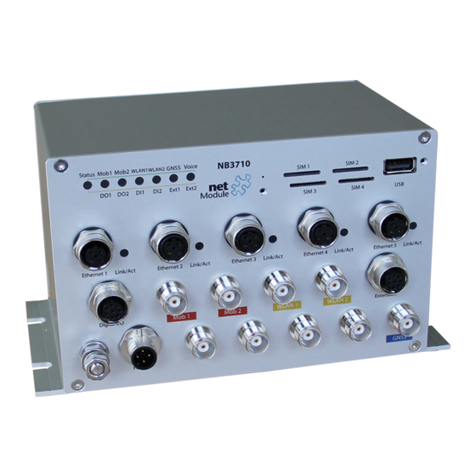
NetModule
NetModule NB3710-LWA User manual
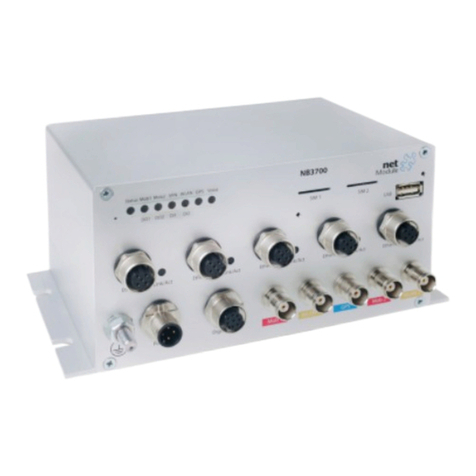
NetModule
NetModule NB3700 User manual
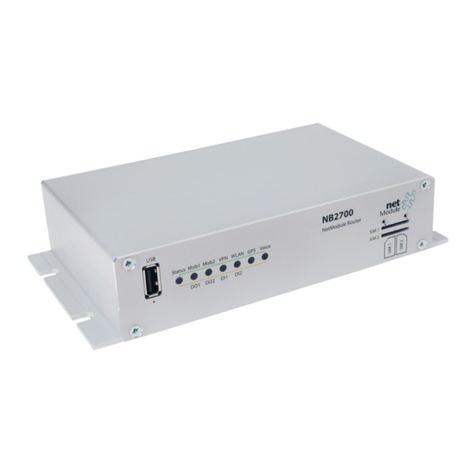
NetModule
NetModule NB2700 User manual
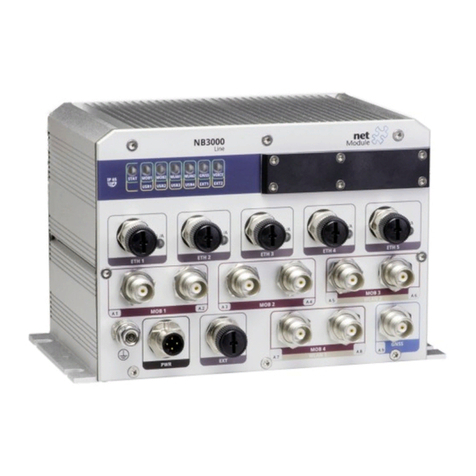
NetModule
NetModule NB3000-Line-Hd User manual
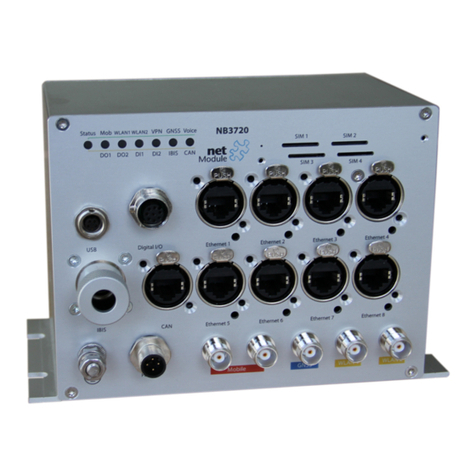
NetModule
NetModule NB3720 User manual
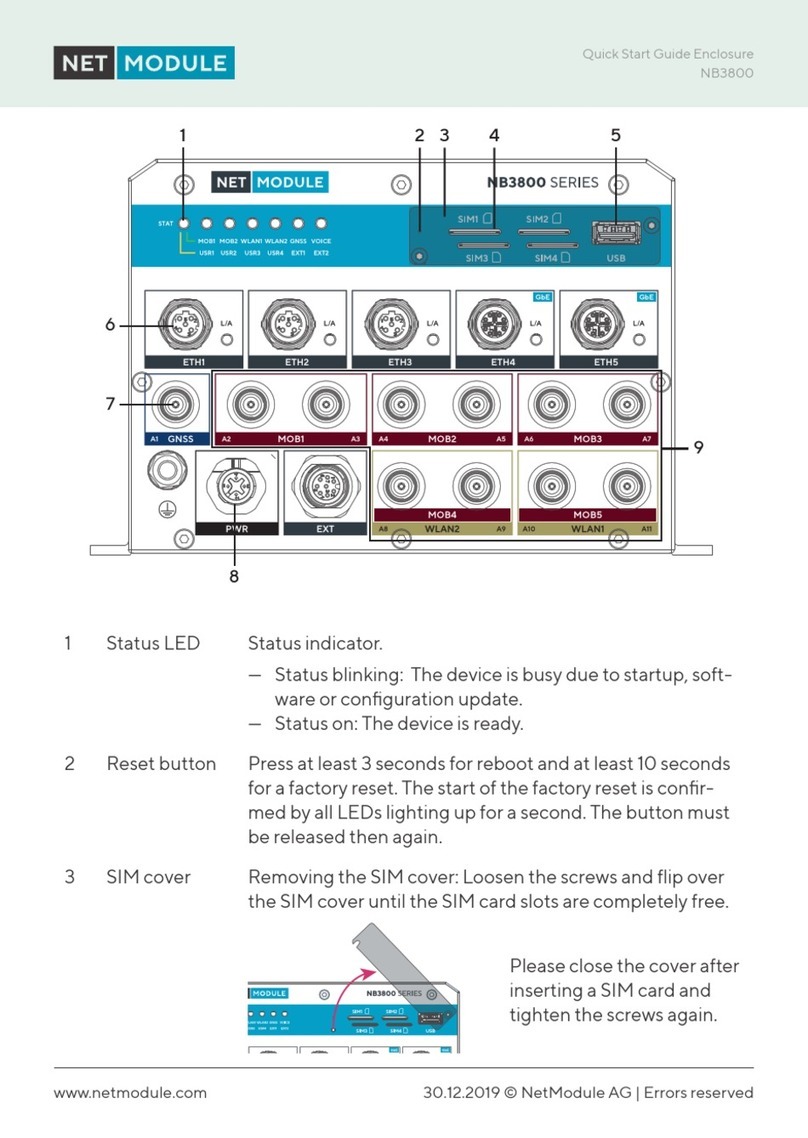
NetModule
NetModule NB3800 Series User manual
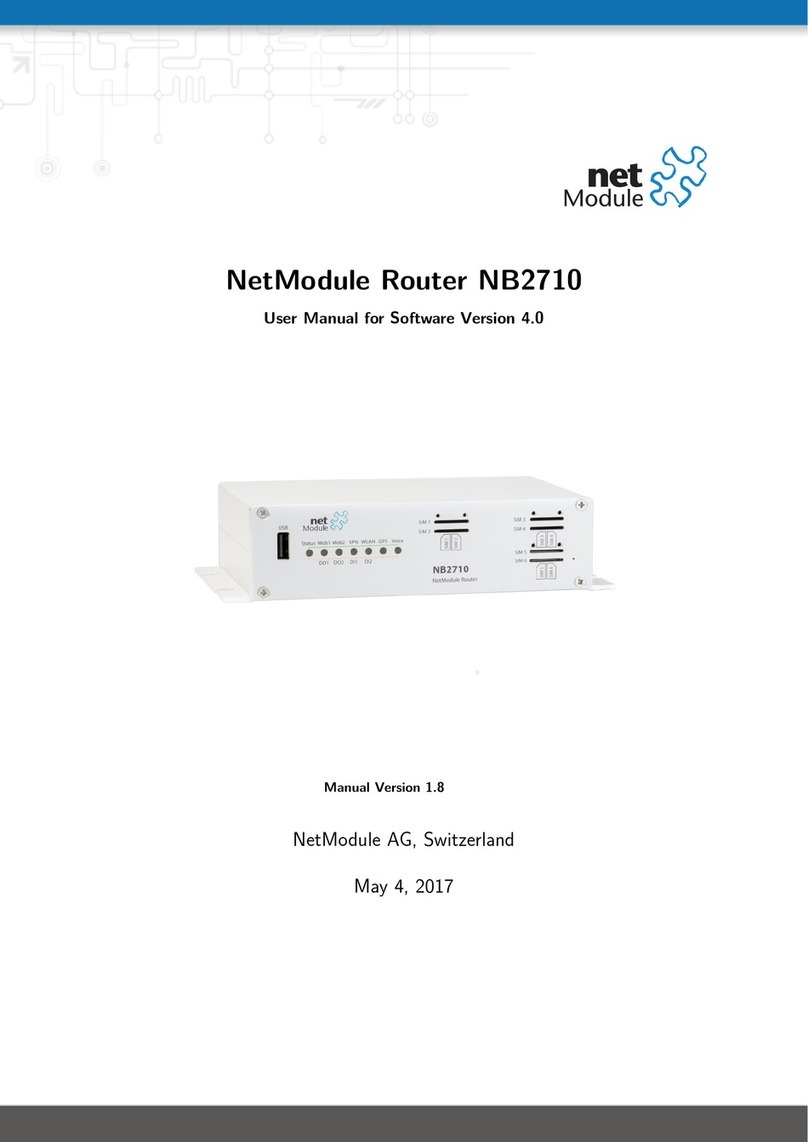
NetModule
NetModule NB2710 User manual
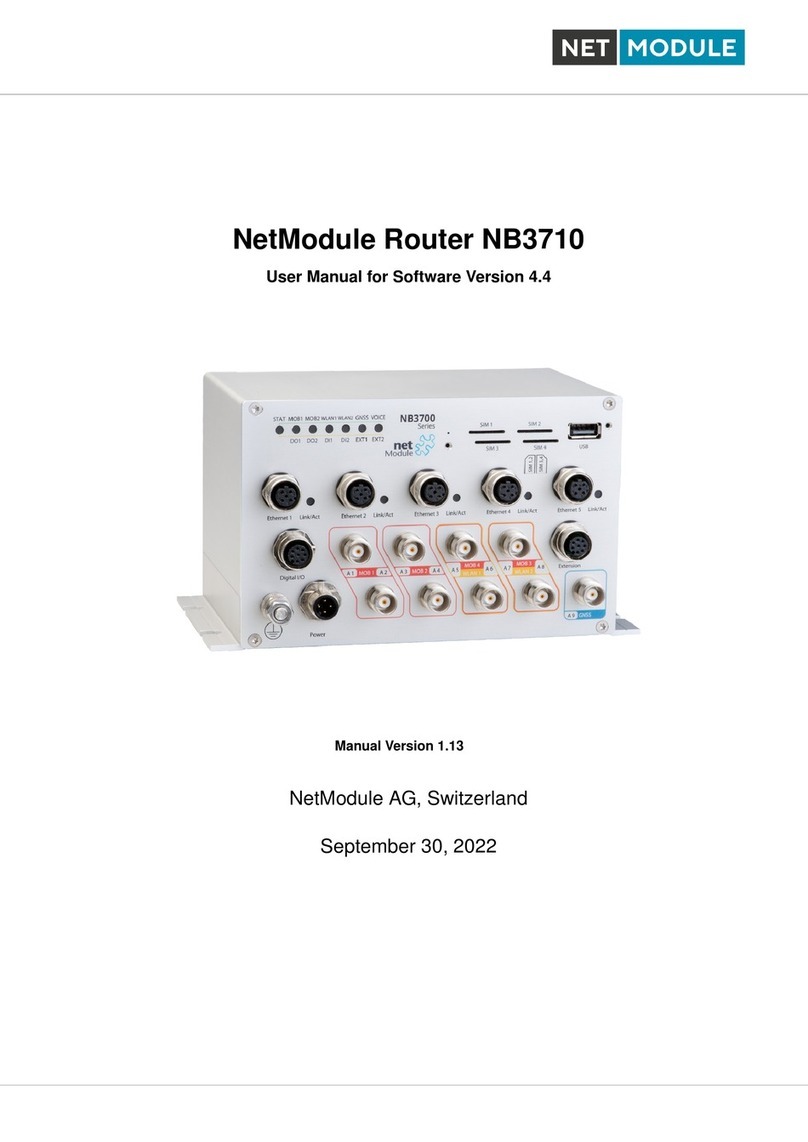
NetModule
NetModule NB3710 User manual
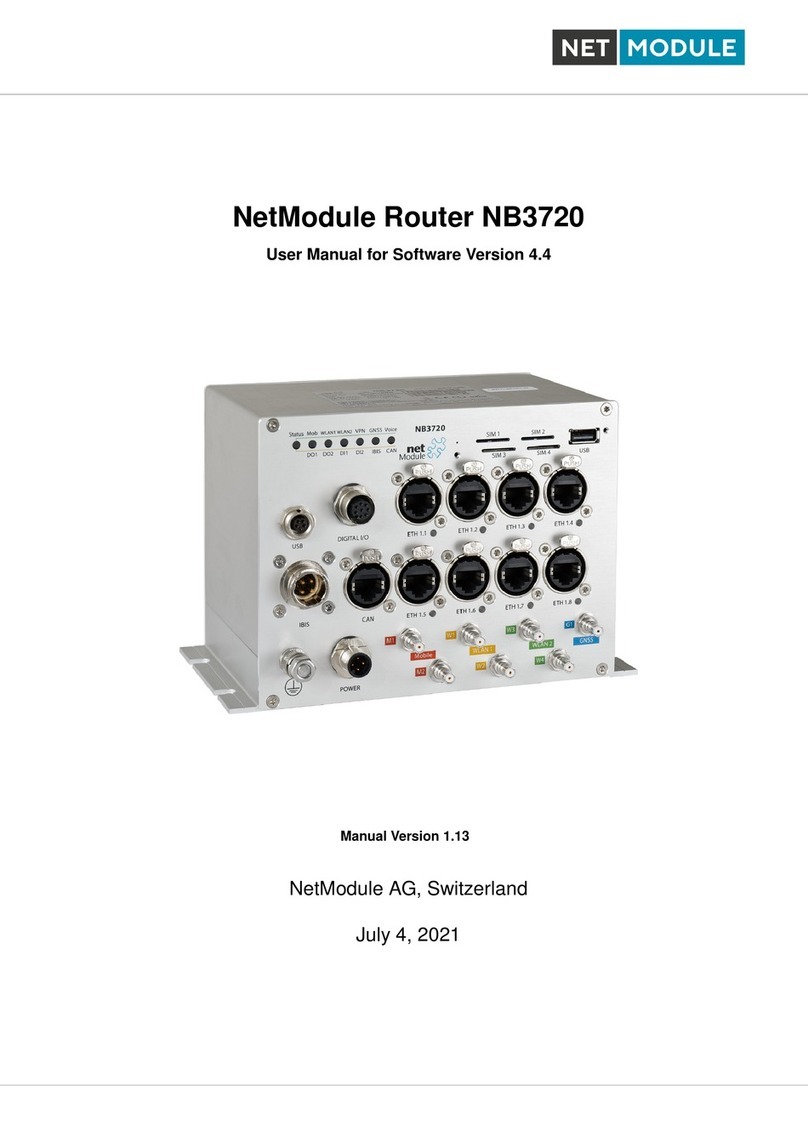
NetModule
NetModule NB3720 User manual
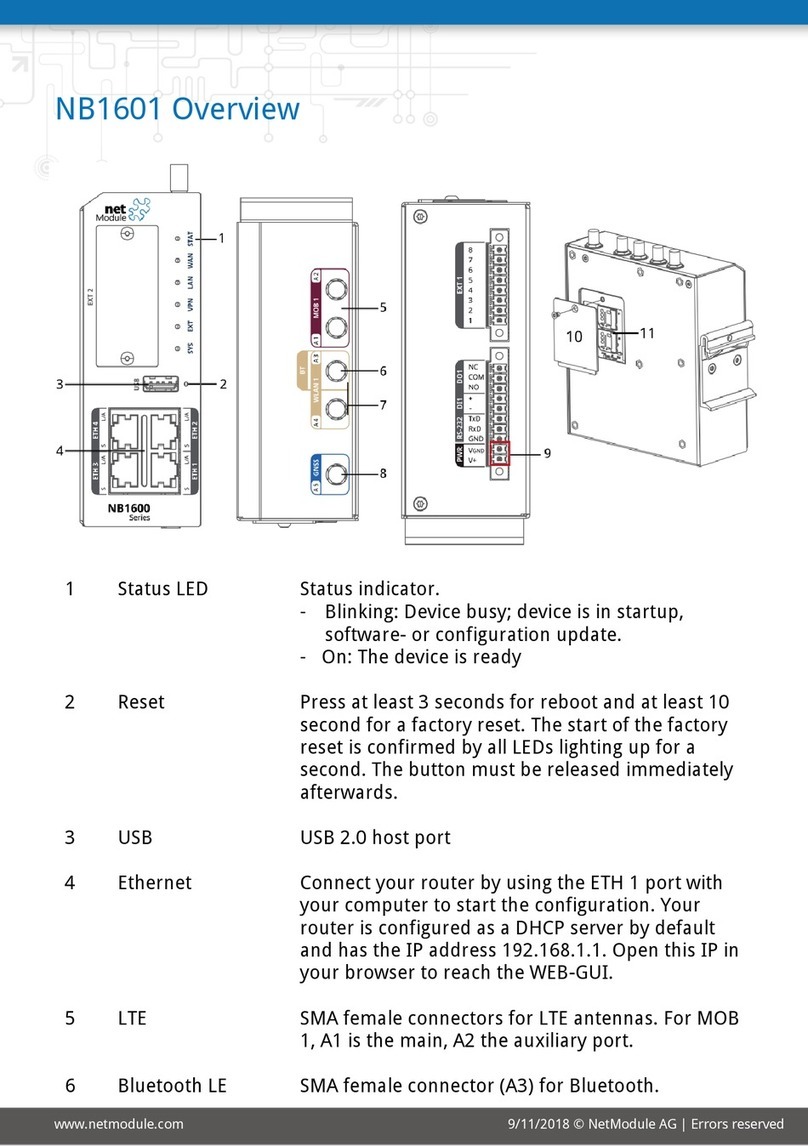
NetModule
NetModule NB1601 Installation guide
